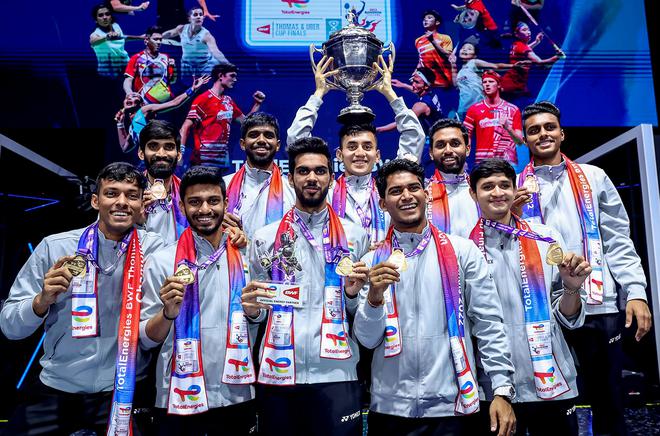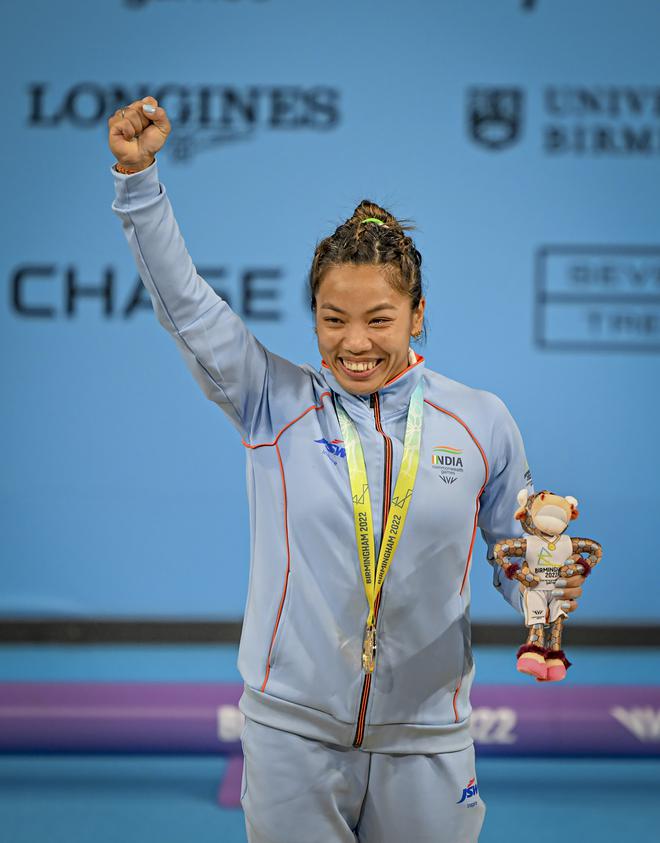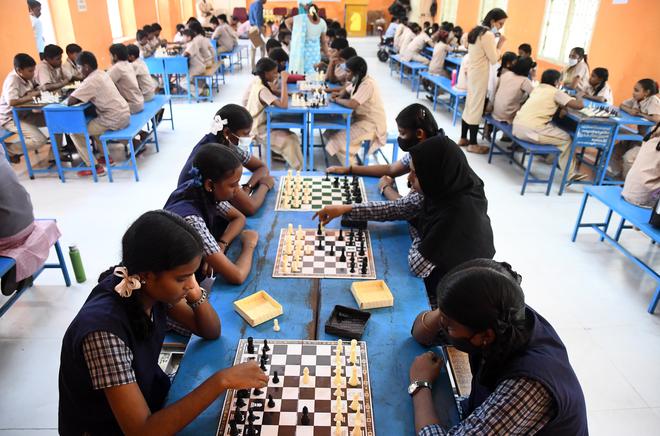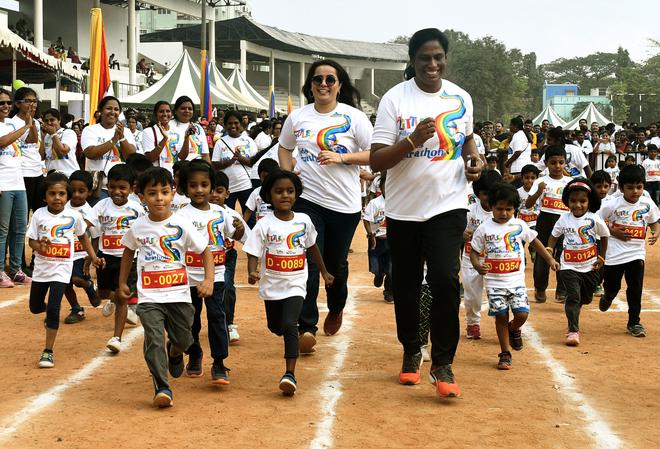Vaishnavi Girish Ramdas, 16, will be taking a year off from academics, after her Class XII exams, so she can focus on pistol shooting. “Vaishnavi wants to be on the Indian team,” says her mother Shri Shakthi Girish, a Chennai-based entrepreneur. “When you have a passion, something like college may interrupt you. As parents, we felt one could always go back to college when you are older.” The teen is now looking at colleges in the U.S. with shooting ranges attached to them.

In Nagpur, Namrata Deshmukh stopped practising as a gynaecologist so she could travel with her daughter Divya for her chess tournaments. A former World Under-10 champion, she won an individual bronze at the Chennai Chess Olympiad recently.
“I am her main sponsor,” smiles her father Jitendra, also a gynaecologist, referring to the struggle to find a sponsor. “Chess is very expensive, contrary to what many people believe. I have had to spend about ₹3 lakh on her recent trip to the UAE, where she played in two tournaments.”
Also Read | A sound ecosystem for Indian sports
India’s sporting culture is no longer just about cricket: there has been a huge leap in multiple games like chess, motorsport, swimming, squash, golf, and other categories as seen in our Commonwealth Games contingent. And parents are investing in their children’s sporting futures: the young athletes are starting early and entering global platforms. Much of this is to do with our homegrown sporting stars, who have won it big in the last couple of decades.
Rewind 20 years
In the summer of 2003, a little-known 16-year-old girl from Hyderabad caused a sensation at Wimbledon. Sania Mirza became the first Indian female to win a Grand Slam, at any level, when she lifted the junior girls’ doubles title, in the company of Alisa Kleybanova of Russia.
About a month after Mirza’s triumph and some four hours drive away from Wimbledon, India’s Under-18 football team won an international youth tournament in Swansea, beating the Brazilian side, Botafogo, in the final. During the course of a few weeks, India also reached the final of the world youth volleyball championship in Thailand; Anju Bobby George won the bronze medal in the women’s long jump at the world athletics meet in Paris; East Bengal won the ASEAN club football championship in Jakarta, and there were also fine performances from the hockey team and a bunch of young chess players. Suddenly, India wasn’t looking like a single-sport nation. It looked too good to be true. And it was.
That summer of hope proved rather a false dawn for Indian sport. Indian sports fans once again had to be content cheering for Manchester United, weeping over Argentina’s failure at the World Cup, gushing over Roger Federer’s artistry, or marvelling at Usain Bolt’s speed .
The big break

Nearly two decades later, in 2021, the country of one billion watched on live television Neeraj Chopra win the first ever athletics gold at the Tokyo Olympics. The Olympics also turned out to be India’s best ever, with seven medals.
In May, India lifted the Thomas Cup (the world team championship for badminton) in Bangkok. At the Commonwealth Games in Birmingham last month, India won 61 medals, 22 of which were gold, as it finished fourth in the medal tally. That was followed by India’s fine showing at the Chennai Chess Olympiad, where the host won the bronze medal in both the open and women’s sections, besides another seven individual medals.
India is finally on its way to realising its potential in a variety of sports, says former Olympian swimmer Nisha Millet. She observes the scenario is a lot different from what it was during her days when she had to stop swimming because of the lack of finance. “My parents sold their house and put their money into my swimming career. Now youngsters like swimmer Srihari Nataraj know that if they do well and market themselves, they will get good endorsements. Our top swimmers, including Sajan Prakash, have big social media followings and endorse a couple of brands.”
Olympic medallists like P.V. Sindhu have a brand value comparable to Indian cricketers, and this is an important trend, according to Millet. “Sindhu and weightlifter Mirabai Chanu are role models for girls who want to do different sports,” says Millet.
“I am glad to find that more Indians are taking up sport and are willing to consult professionals like sports nutritionists, therapists and strength and conditioning coaches. At my academy in Bengaluru, where more than 6,000 people, of various ages are training in swimming, many are kids with vital parental support.”
A. Nazar, a Kozhikode-based badminton coach, sees a change in the attitude of parents. “And that helps the children immensely. I have seen many talented players, like Ayyappan Krishnan of Kerala, quitting the sport in order to pursue their academics, but now you have players who don’t even go to school and devote their time to training.”

You would find young men like racing driver Akhil Rabindra, 26, who are determined to make a career in the sport. After graduating from the University of Edinburgh, he has chosen to remain in the U.K. for the sake of motorsport. “I was racing here while I did my course in sports and recreation management,” Rabindra says over phone from Coventry where he is working now. “I feel this is the right time for a young Indian to start a career in motorsport. There are more opportunities and better support from corporates.”
Private participation has increased: companies such as Reliance, Kotak Mahindra, Tata Steel and JSW have contributed to the improved profile of Indian sport. Reliance Foundation (RF) has been supporting athletes in different sports, from the grassroots to the elite level. “During the past one year, the RF-supported athletes bagged 12 international and 29 national medals in athletics, archery, badminton and weightlifting,” says a spokesperson from the foundation. “ RF supported 140 elite athletes preparing for global competitions, working closely with coaches, the government and sports federations. The foundation continues to work with partners such as the Odisha government, Athletics Federation of India, and the Indian Olympic Association.”
State largesse

The Odisha government’s attitude towards sport has been commendable. The State has emerged in little time as a sports hub and is the sponsor of India’s men’s and women’s hockey teams. Its joint venture with RF, the Reliance Foundation Odisha High Performance Centre, is already showing results in athletics, under the English coach James Hillier.
And the way the Tamil Nadu government hosted the Chess Olympiad at a notice of just four months received much-deserved praise. The Centre has also increased its budgetary allocation to sports considerably, although more could be done. It is perhaps too early to determine the impact of the Khelo India project, for which ₹974 crore was earmarked in the last budget. But the tendency by the various State governments to shower champion athletes with cash awards, running into crores of rupees, still continues, rather than timely investment on the champions of tomorrow. Instead of politicians, more athletes could come into the administration.
The way sport is run in the country still needs drastic improvement. In August, the women’s football team of Gokulam Kerala had to return from Uzbekistan after being disqualified from the AFC Asian Club championship, as a result of the world governing body FIFA’s ban on the All India Football Federation. The ban, which has since been lifted, was for ‘undue influence from third parties, but the damage to Gokulam cannot be undone.
Indian fans indeed deserve a stronger football team, which is ranked 104th in the world. The Indian Super League has certainly helped. In fact, the professional leagues for various sports, after the success of cricket’s Indian Premier League, have been a positive development. “We need to have proper planning to improve the standard of football,” says Bhaichung Bhutia, one of India’s greatest footballers. “We should aim at getting into Asia’s top 10 first, and that is a feasible goal.”

Indian athletics too has the potential to improve, says track legend P.T. Usha, who became a coach after her stellar career. “Our men’s long jump is now world-class and the triple jump to looks promising,” she says. “But athletics needs more funding from the State and corporate houses; I have even had to turn to crowd-funding to run my Usha School of Athletics.” It is indeed time that sports authorities and governments paid attention to all sport not just the top three.
As Deepak Raj, triathlon coach, and 22-time IRONMAN finisher, says, “We are getting more competitive not only in mainstream sports but also in new ones or those considered tier 2 or 3. For instance, we won a lawn bowls gold at the recent Commonwealth Games, and got into the top 10 in the triathlon.” Much of this success owes to both the growth and intersection — from new academies, foundations and NGOs, to grassroots training and more events, he says.







